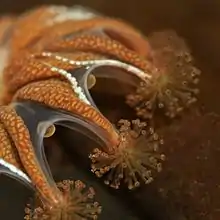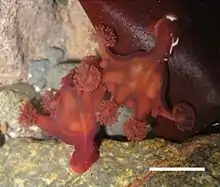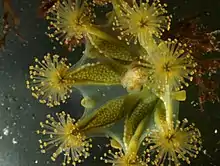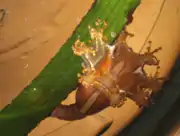Staurozoa
Staurozoa is a class of Medusozoa, jellyfishes and hydrozoans. It has one extant order: Stauromedusae (stalked jellyfishes). A fossil group called Conulariida has been proposed as a second order,[2] although this is highly speculative. The extinct order is largely unknown and described as a possibly cnidarian clade of marine life with shell-like structures, the Conulariida. Staurozoans are small animals (1–4 cm or 0.4–1.6 in) that live in marine environments, usually attached to seaweeds, rocks, or gravel.[3] They have a large antitropical distribution, a majority found in boreal or polar, near-shore, and shallow waters. Few staurozoans are found in warmer tropical and subtropical water environments of the Atlantic, Indian, and Pacific Ocean basins, but most are known from the Northern Hemisphere.[3] Over the years their number of species has increased, thus right now it is said to have an estimated 50 species.[4]
| Staurozoa | |
|---|---|
 | |
| Scientific classification | |
| Kingdom: | Animalia |
| Phylum: | Cnidaria |
| Subphylum: | Medusozoa |
| Class: | Staurozoa Marques & Collins, 2004 |
| Orders | |
Gallery
 Haliclystus sp.
Haliclystus sp.


References
- Liu, A. G.; Matthews, J. J.; Menon, L. R.; McIlroy, D.; Brasier, M. D. (22 October 2014). "Haootia quadriformis n. gen., n. sp., interpreted as a muscular cnidarian impression from the Late Ediacaran period (approx. 560 Ma)". Proceedings of the Royal Society B: Biological Sciences. 281 (1793): 20141202. doi:10.1098/rspb.2014.1202. PMC 4173675. PMID 25165764.
- Marques and Allen (2004). "Cladistic analysis of Medusozoa and cnidarian evolution". Invertebrate Biology. 123 (1): 23–42. doi:10.1111/j.1744-7410.2004.tb00139.x. Retrieved 29 September 2020.
- Collins, A. G. (n.d.). Staurozoa. AccessScience. doi:10.1036/1097-8542.652700
- Miranda, Lucília S.; Mills, Claudia E.; Hirano, Yayoi M.; Collins, Allen G.; Marques, Antonio C. (2018-12-01). "A review of the global diversity and natural history of stalked jellyfishes (Cnidaria, Staurozoa)". Marine Biodiversity. 48 (4): 1695–1714. doi:10.1007/s12526-017-0721-4. ISSN 1867-1624. S2CID 11242035.